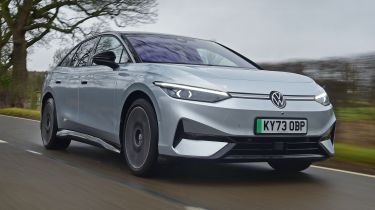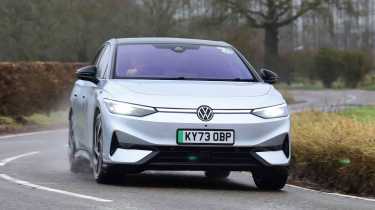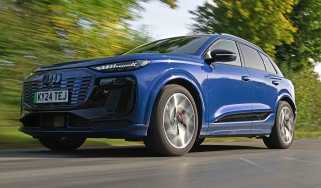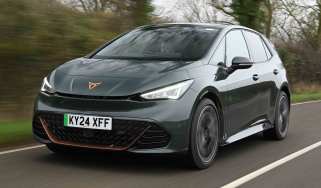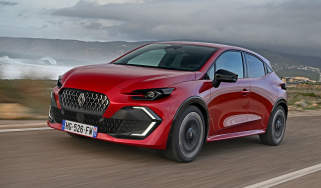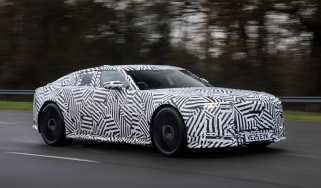Volkswagen ID.7 review
The Volkswagen ID.7 is the brand’s best EV to date, offering plenty of range and tonnes of practicality

Our opinion on the Volkswagen ID.7
With the march towards electrification gathering pace and the arrival of ever more efficient EVs that can go further on a charge, the Volkswagen ID.7 needs to be good. And thankfully, the German brand has worked hard to learn from experience with its early EVs.
In terms of its cabin, technology and general driving experience, the ID.7 easily justifies its price tag. The VW has every right to be considered in the same sentence as cars like the Tesla Model 3 – as well as considerably pricier rivals.
About the Volkswagen ID.7
The Volkswagen ID.7 is one of the brand’s biggest electric cars to date; it’s a full 249mm longer than the short-wheelbase VW ID.Buzz, for example.
As already mentioned, the ID.7 isn’t the only Volkswagen EV, and even if the reaction to the company’s early efforts was a little lukewarm, you could hardly accuse VW of resting on its laurels. Following limp launches for the VW ID.3, VW ID.4 and VW ID.5, the bold-looking VW ID.Buzz won us over with its charming personality and practical interior.
The ID.7 is up against other electric executive cars such as the BMW i4, Hyundai Ioniq 6, Polestar 2, and Tesla Model 3. Whereas the ID.7 merely matches the smaller Tesla from a handling perspective, it punts it into next week when it comes to practicality. However, while the Volkswagen will be better for a family holiday, the ID.7 still sits behind the Model 3 when it comes to electric efficiency and charging speeds. That’s a shame, considering the ID.7 is more expensive.
Volkswagen ID.7 pricing and latest deals
The ID.7, which acts as the flagship for VW’s electric car range, starts at over £51,000. Those looking to go further on a charge will need to stump up around £54,500 for the larger battery pack in the Pro S variant, while the four-wheel-drive GTX comes in at around £59,000.
Used - available now

2025 Volkswagen
Id.7
5,574 milesAutomaticElectric
Cash £38,999If you’re making the move to an electric car and feel like the Volkswagen ID.7 is the one for you, there are plenty of great deals to be found via our Buy a Car service. You can configure your ideal Volkswagen ID.7 and receive top offers from our huge network of dealers, browse the very latest ID.7 leasing deals or take a look at the best used ID.7 models. If you already have a car and need to sell it, be sure to visit our Sell My Car page.
Performance & driving experience
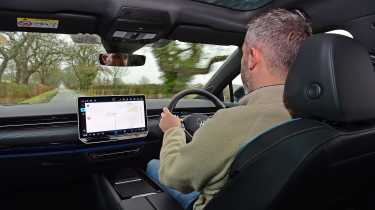
| Pros |
|
| Cons |
|
In short, the Volkswagen ID.7 does a good job of hiding its size, but it lacks the ultimate agility of a BMW i4 or Model 3 point-to-point, tending to lean over more in bends and feeling lazier to respond to quick changes of direction. It also isn’t as quick as its Model 3 rival in standard form, although anyone coming to the ID.7 from a traditional petrol or diesel car is unlikely to be disappointed. Refinement and ride comfort are ID.7 strong points, which go hand in hand with it being a long-distance EV.
Electric motors, 0-60mph acceleration and top speed
Even with a not inconsiderable 282bhp on tap in the ID.7, its 2,100kg weight (the four-wheel-drive GTX is 2,253kg) means that performance is some way off the class best. Don’t get us wrong, a 0-62mph time of 6.5 seconds (6.6 seconds for the heavier Pro S version) isn’t anything to be sniffed at, because it compares well with a traditional petrol or diesel car. But you’ll need the costliest GTX version with 335bhp in order to beat the acceleration times of even the entry-level Tesla Model 3 RWD or single-motor Polestar 2.
The 5.4-second 0-62mph sprint of the GTX is still more than swift enough in the real world, but it isn’t going to eclipse the sub-3.0-second 0-62mph time of the cheaper Tesla Model 3 Performance. All versions of ID.7 have a top speed of 112mph, which is more than enough in the UK, and would only be important in countries with an unlimited top speed on their motorways.
| Model | Power | 0-60mph | Top speed |
| Pro Match | 282 bhp | 6.5s | 112 mph |
| Pro S Match | 282 bhp | 6.6s | 112 mph |
| 4Motion GTX | 335bhp | 5.4s | 112 mph |
Town driving, visibility and parking
At nearly five metres long, the ID.7 isn’t going to be the easiest car to slot into a parking space, but the 360-degree camera system and parking sensors front and rear give you some assistance.
All the controls are smooth, although we would like there to be more adjustment in the regenerative braking system. It works automatically by increasing the regenerative braking as you approach junctions, or by using information from either the navigation system, or from the camera and radar systems to spot slower-moving traffic ahead of you. Alternatively, it can be on all the time when you lift off the accelerator if you’ve engaged the ‘B’ mode on the gear selector. The latter isn’t quite strong enough to offer the one-pedal driving mode of cars like the Model 3 or the e-Pedal system used in then Nissan Ariya, though.
Other than that, the ride is commendably supple at low speeds despite the big 19-inch alloy wheels that come as standard, especially when you have the optional adaptive suspension that’s available in conjunction with the Exterior Pack Plus. This allows you to soften the suspension to deal with the harshest shocks from potholes and speed bumps.
B-road driving and handling
We found the optional adaptive suspension provides excellent damping at higher speeds. Even when paired with the largest 20-inch wheels and the suspension in its firmest setting, the ID.7 still manages to deal with bigger bumps well and feels resolutely tied down at all times, if a touch fidgety over rougher road surfaces. In its softest setting, that slight fidget disappears, and the ID.7 feels positively serene, floating over uneven surfaces that rivals like the Hyundai Ioniq 6 and Polestar 2 would jiggle over. As you’d expect, this makes the ID.7 an incredibly refined long-distance cruiser, yet that sense of being isolated from the outside world doesn’t come at the expense of body control, and the ID.7 has an inherently wide track that aids stability.
Even in the pouring rain and in single-motor guise, the ID.7 provides all the traction you need. For those after something even more capable in slippery conditions, a dual-motor GTX model with the added traction of four-wheel drive is also available. This version doesn’t feel any sportier than the standard ID.7, but you can sense the front motor kick in to drag you out of trouble should the back of the car start to slip a little in a tight bend.
There’s no getting around the fact that the ID.7 is a very heavy car, though. All versions weigh over two tonnes, and even in its firmest driving mode, the ID. 7 cannot disguise the fact that it is a big car, clearly set up for comfort rather than driving thrills. It would be good if there were a little more bite to the brake pedal, because it feels a bit soft and doesn’t give you the same confidence when driving quickly as you get from the BMW i4 or Tesla Model 3.
Motorway driving and long-distance comfort
The Volkswagen ID.7 is definitely the most grown-up of Volkswagen’s electric car range – and this feeling continues at higher speeds. Laminated side windows (the optional Exterior Pack Plus adds laminated side glass for the rear passenger doors) make this an almost eerily quiet car at low speeds, but even on the motorway, the ID.7 remains impressively refined, even when fitted with the largest 20-inch wheels.
All versions come with an adaptive cruise control system with lane assist to offer a semi-autonomous driving experience. When switched on, it helps with steering and braking to take some of the strain out of long drives, and manages to keep you centred in your lane, avoiding the sensation that you’re being bounced between the markings.
“Volkswagen’s ID.7 Tourer is the size of an aircraft carrier, which would probably be easier to manoeuvre on my wide driveway – five-point turns are common.” - Phil McNamara, editor-at-large
Range, charging & running costs

| Pros |
|
| Cons |
|
The entry-level Volkswagen Pro can cover up to 379 miles on the WLTP combined cycle, while the larger 86kWh battery pack in the Pro S increases claimed driving range up to 433 miles. The added performance of the ID.7 GTX comes at the cost of some battery range, with the same 86kWh battery pack only being able to cover up to 364 miles on paper.
Electric range, battery life and charge time
During a group test with its five main rivals, we found the VW ID.7 was the third most efficient car, but the 3.4mi/kWh we measured still only equates to an overall real-world range of 262 miles with the 77kWh battery pack. We got a slightly better 3.6mi/kWh from our long term ID.7 Pro S Tourer over the course of 5,000 miles, which equates to 310 miles from its 86kWh battery. Neither of these test cars had the then optional heat pump (now standard), which helps to improve the car's efficiency in cold weather.
Rapid charging is possible at up to 175kW for the 77kWh Pro model – matching the base Tesla Model 3. The 86kWh Pro S ups the charging speed to 200kW, but that falls short of the Tesla Model 3 Long Range, which is capable of 250kW top-ups.
We tested an ID.7 Tourer Pro S during our electric car charging speed test and discovered that it'll maintain its advertised 200kW peak charging speed until the battery gets to 50 per cent state of charge. That enabled a short 21-minute 20 to 80 per cent top up charge, and it could also handle 80 to 100 per cent fill up in 16 minutes. That was a quarter of the time it took a pre-facelift Tesla Model Y and a Peugeot E-3008 to achieve the same feat.
It is possible to precondition the battery ahead of visiting a rapid charger, either through route planning in the sat-nav system, or manually in the battery sub-menu. This is helpful because the car doesn’t have to waste time preparing the battery before ramping up to accept the maximum charging speed when you plug in, which will save time if you have to make multiple charging stops during a journey.
Those who have access to a 7.4kW wallbox charger at home should be able to refill a flat battery (a worst-case scenario) in a little over 12 hours with the Pro version, and just under 14 hours with the Pro S and GTX models.
| Model | Battery size | Range | Insurance group |
| Pro Match | 77kWh | 379 miles | 39E |
| Pro S Match | 86kWh | 433 miles | 39E |
| 4Motion GTX | 86kWh | 364 miles | 41E |
Insurance groups
Insurance for an electric car isn’t as inexpensive as an equivalent petrol or diesel car, and the group 39 rating for the Volkswagen ID.7 Pro and 39 for the Pro S are indeed quite high. In fact, these groups are a little higher than the Tesla Model 3 RWD, which starts in group 36, but the ID.7 should at least be more affordable to insure than the BYD Seal, which starts in group 48.
The high-performance ID.7 GTX will be the most expensive model in the range to insure because it starts in group 41.
Tax
Electric cars like the ID.7 will cost company car drivers less in terms of lower Benefit-in-Kind (BiK) tax rates compared to traditional petrol, diesel, or even hybrid-powered cars because of zero-tailpipe emissions. However, electric cars are now liable for VED road tax. The ID.7’s starting price brings the entire line-up well within the luxury car tax bracket, too. If you want to avoid this particular charge, you’ll want to look towards an entry-level Tesla Model 3.
Depreciation
The VW badge is a known quantity, which helps with regard to desirability and the predicted resale values of the ID.7 compared with its rivals. According to our expert data, the ID.7 is likely to retain between 42 and 45 per cent of its resale value over three years or 36,000 miles, which is much better than the 38 to 43 per cent a Polestar 2 is expected to retain, or the 42 to 43 per cent the Hyundai Ioniq 6 is likely to hold onto over the same period.
To get an accurate valuation for a specific model, check out our free car valuation tool...
Interior, design & technology
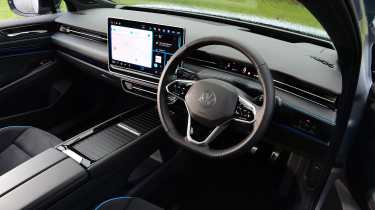
| Pros |
|
| Cons |
|
The Volkswagen ID.7 differs from the Tesla Model 3 and Hyundai Ioniq 6, in that while it resembles a similar saloon design, the ID.7 is a hatchback, much like the BMW i4.
The more practical hatchback bodystyle doesn’t hurt its aerodynamic efficiency, though, because the ID.7 has an impressively low drag coefficient of 0.25, which is handy for extending its electric range compared with bulkier electric SUVs.
You have a choice of six colours with the ID.7, and four of those – Stonewashed Blue, Scale Silver, Glacier White and Aquamarine Blue – can be specified with a contrasting black roof. None of them is quite as bright as the colours available on the BMW i4 or Tesla Model 3, but at least you won’t be hit with a hefty bill (between £1,300 - £2,000 in the case of the Model 3) if you want metallic paint on your ID.7.
Every ID.7 comes in well-equipped. Our preferred Match Plus trim includes:
- Adaptive matrix-LED lights
- 19-inch wheels
- Three-zone climate control
- A 15-inch Discover Pro infotainment system with wireless Apple CarPlay and Android Auto
- An augmented-reality head-up display
The four-wheel drive GTX Plus models feature unique 20-inch alloy wheels, an upgraded Harman Kardon sound system, ventilated front seats, adaptive suspension, and sportier exterior styling.
Interior and dashboard design
It’s all quite smart inside the ID.7, but don’t expect any bright colour choices because the palette is a sombre one. If you want something beyond black, grey and silver, you’ll have to make use of the 30-colour ambient interior lighting system.
The main controls are a little confusing at first – the wipers are embedded on a stalk to the left of the steering wheel, rather than the right, for example – but at least they’re not buried within the touchscreen, and you still get indicators on a stalk, unlike on the Tesla.
One thing that is now lost within the screen is the adjustment of the central air-vent controls. As has been the case for decades now, you had simple manual controls to direct the airflow, but VW has followed Tesla's example of automating this adjustment and sticking it within the screen. In our view, it makes what was once an easy adjustment needlessly complicated.
Materials and build quality
Let’s first address the elephant(s) in the room. Volkswagen’s early ID cars came under heavy criticism for their lacklustre interior quality, plus fundamental failings in their technology and infotainment. With the ID.7, the maker is looking to right those wrongs.
Indeed, from the driver’s seat, all appears well. The general cabin ambience has been lifted to a level that easily competes with cars in this class; there are soft-touch materials on the doors and dash, and the seats offer plenty of support.

Infotainment, sat-nav and stereo
The Volkswagen ID.7’s big, bright, 15-inch central display instantly feels more responsive than in the maker’s previous electric offerings. The menu layout still has some controls buried deep within sub-menus, but at least the large screen in the ID.7 allows some frequently used functions to be on permanent display, such as the climate controls at the bottom of the screen.
Volkswagen has deemed it appropriate to backlight the adjustment sliders for the climate temperature and audio volume settings located at the base of the screen, allowing you to find them more easily in the dark. They’re still touch-sensitive, which means they’re not as easy to adjust on the move as the physical climate controls of the Hyundai Ioniq 6. Overall, we still prefer the BMW i4’s clickwheel design because it makes controlling an infotainment system much easier while on the move.
Wireless smartphone connectivity and a wireless phone charging pad are standard. All ID.7s come with a nine-speaker audio system with DAB radio, but you’ll need to pay for the pricey £2,000 Interior Pack to get the upgraded 12-speaker, 700-watt Harman Kardon sound system.
“We’re still not fond of the digital interfaces, but VW’s continual improvements in this department do mean that while some of the ID.7’s controls still grate, there’s now enough screen real estate to place permanent buttons on-screen, such as shortcuts to the media, nav and safety systems.” - Jordan Katsianis, senior staff writer
Boot space & practicality

| Pros |
|
| Cons |
|
The Volkswagen ID.7’s large hatchback body gives it a practical advantage over rivals in this large EV class that stick with the traditional saloon format. All ID.7 models come with front and rear parking sensors, plus a 360-degree camera system to improve visibility when parking – although the latter has a lower-resolution feed than we’d expect of a car costing over £50,000. Standard LED-matrix headlights provide excellent visibility at night while also adjusting the beam pattern to avoid dazzling oncoming traffic.
Dimensions and size
The car’s length alone means the Volkswagen is a much more spacious car than a BYD Seal or Tesla Model 3. The ID.7 is 241mm longer than the Model 3, and 161mm longer than a Seal, so factor that into your calculations about where you’ll park it. The ID.7 isn’t as wide as the Seal, but it is taller than both of its rivals.
Go for the ID.7 Tourer, and both the length and width remain the same as the hatchback, but the height goes up by 15mm to 1,551mm.
| Dimensions comparison | |||
| Model | Volkswagen ID.7 | BMW i4 | Tesla Model 3 |
| Length | 4,961mm | 4,783mm | 4,720mm |
| Width | 1,862mm (2,141mm inc mirrors) | 1,852mm (2,073mm inc mirrors) | 1,933mm (2,089mm inc mirrors) |
| Height | 1,536mm (1,535mm GTX) | 1,440mm | 1,448mm |
| Wheelbase | 2,971mm | 2,856mm | 2,875mm |
| Boot space | 532-1,948 litres | 470-1,290 litres | 594-977 litres |
Seats & passenger space
Adults who are six feet tall will have no trouble getting comfortable in the front of the ID.7. All versions come with electrically adjustable front seats with memory settings on the driver’s seat, and there’s electric lumbar support for additional comfort. There’s also plenty of head, leg, and shoulder room to stretch out in.
The centre console is tall and there’s plenty of storage space under the centre armrest, plus a pair of cup-holders ahead of it under a roller cover. The front door bins are generously sized and are flocked to prevent items from rattling in them as you drive along.
The vast length and wheelbase of the ID.7 is really noticeable in the back, where the kneeroom is limo-like, and (according to our tape measure) headroom is far more generous than in the likes of the BMW i4 or Tesla Model 3. The well equipped Match trim comes with electric adjustment on the front seats, including electric lumbar adjustment, memory settings, and seat-depth adjustment, so there’s plenty of scope to find a comfortable driving position.
Families with young children who need child seats will be pleased to find Isofix child seat mounting points conveniently hidden behind some removable plastic covers on the outer positions of the rear seats. There are also Isofix mounts on the front passenger seat to provide some flexibility in where you can put child seats.
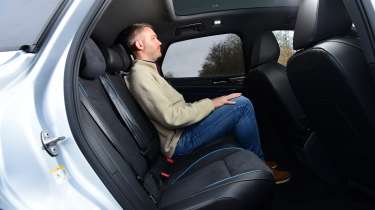
Boot space
Put simply, the Volkswagen ID.7 has a huge 532-litre boot that dwarfs the Model 3’s 425-litre luggage area. Folding the rear seats down in the ID.7 increases capacity up to 1,586 litres, with the 60:40-split bench lying almost flat, making an IKEA run that little bit easier. All models feature a variable-height boot floor, which eliminates the annoying load lip and provides space beneath the floor for storing charging cables or, if necessary, the tonneau cover.
There is the Volkswagen ID.7 Tourer estate, which offers even more boot space, with 605 litres available with the seats up and 1,948 litres with the seats down – a figure even greater than that of a similarly configured Skoda Superb Estate or Mercedes E-Class Estate.
Despite the saloon shape being less practical than a traditional estate, the ID.7 still has a roof-hinged hatch, which works wonders for accessibility when loading bigger items. The boot opening in the ID.7 is significantly larger than the narrow, letterbox-like opening found in both the BYD Seal and Tesla Model 3.
Towing
With the introduction of the Pro S version, the Volkswagen ID.7 can be ordered with a tow bar (for just over £1,000) to complement this version's 1,000kg braked towing capacity. Opting for the four-wheel-drive GTX model not only helps with traction on wet grass, but also increases the towing capability to 1,200kg.
Neither figure is a huge amount for a car of this size and weight. If you want more capacity and still need some electrified driving, the plug-in eHybrid versions of the Volkswagen Tiguan and Volkswagen Passat can both handle a 1,800 kg caravan or trailer.
“Its big-car space still delights. My five-person household does not pack light, but the ID.7 Tourer easily swallowed our Easter road trip’s suitcases, provisions and coats under the tonneau cover. And folding the seats creates a low-roof van that aces trips to the recycling centre.” - Phil McNamara, editor-at-large
Reliability & safety
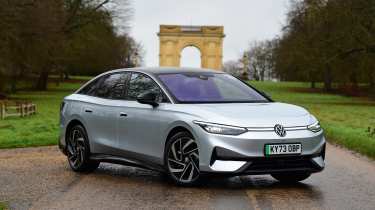
| Pros |
|
| Cons |
|
The Volkswagen ID.7 is yet to appear in our Driver Power owner satisfaction survey. However, the Volkswagen brand has its work cut out because it hasn't improved much over its 2024 score (29th out of 32), finishing in a disappointing 27th position out of 31 in our 2025 survey. That puts it behind Ford (23rd), Hyundai (20th), Skoda (12th), and BMW (8th).
At least the ID.7 should be a very safe place to put you and your loved ones if you do end up in a collision. It received the maximum five-star rating from safety experts Euro NCAP in 2023, with higher scores in all areas than the BYD Seal.
As you’d expect with such a high score, the ID.7 comes loaded with safety features and assistance technology. There’s autonomous emergency braking (AEB) to help mitigate or prevent low-speed collisions with other vehicles, cyclists and pedestrians. You also get adaptive cruise control to keep you a safe distance from the vehicle in front, as well as lane-keeping assist to help maintain your position within the lane.
Blind-spot monitoring alerts you to vehicles approaching alongside you when you change lanes. It also works while you're parked at the side of the road to prevent you from opening a car door and stepping out into the path of a vehicle approaching you. The ID.7 comes with a rear cross-traffic alert system to let you know of vehicles crossing your path as you go to reverse onto a busy main road.
Volkswagen has a fairly standard three-year/60,000-mile warranty, which can’t quite match the unlimited mileage policy provided by BMW. The battery pack comes with a separate eight-year/100,000-mile warranty, which guarantees that the battery pack will retain above 70 per cent of its capacity over that period, or it’ll be replaced under warranty.
| Euro NCAP safety ratings | |
| Euro NCAP safety rating | 5 out of 5 stars (tested 2023) |
| Adult occupant protection | 95% |
| Child occupant protection | 88% |
| Vulnerable road user protection | 83% |
| Safety assist | 80% |
Buying and owning
Best buy: Volkswagen ID.7 Pro 77kWh Match Plus
While a larger 86kWh battery is available, the 77kWh unit still offers a considerable 379 miles on the WLTP combined cycle. Our real-world testing of this model returned an average efficiency of 3.4 miles per kWh, which is equivalent to around 262 miles. This should still prove more than enough for most people’s day-to-day driving needs.
This isn’t a cheap car, but thankfully, VW throws in a fair amount of kit into the entry-level Pro Match Plus model. A heat pump, keyless access, augmented reality head-up display, heated windscreen, adaptive LED headlights and massage seats are all included.
Volkswagen ID.7 alternatives
As we already mentioned, people considering the Volkswagen ID.7 are likely to be comparing it with the Tesla Model 3, and if ease of charging away from home and overall efficiency are your major concerns, then the ID.7, unfortunately, comes up a little short. That’s not to say it can’t handle a long trip, because every ID.7 uses a sizeable battery pack (77kWh or 86kWh) that can be recharged at a relatively fast speed. But the Model 3 is just that little bit further ahead in terms of getting the most from your volts, according to our real-world testing, and Tesla's infrastructure is second to none.
However, the ID.7 is leagues ahead of the Model 3 (and many of its other rivals) when it comes to practicality. The VW is significantly bigger, meaning it can cope with family life much better, especially if you have older (and taller) children. Comfort is also a major plus point, particularly with the adaptive suspension. True, the ID.7 can’t out-handle a Model 3 or BMW i4, but to buyers who just want a car that's comfortable and refined, that won’t matter very much.
Latest deals on the ID.7 and rivals
Volkswagen ID.7 pictures
Key updates of the Volkswagen ID.7 review
- 18 November 2025: updated to include how the VW ID.7 performed in our electric car charging test.
- 3 February 2025: review updated to reflect how the ID.7 compares with its rivals after our electric company car megatest.
Frequently Asked Questions
Like the rest of the ID line-up, the ID.7 only requires servicing every two years, with no specified mileage limits. A service plan can be set up at the time of purchase for a lump sum of £249.
